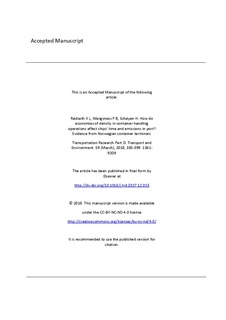| dc.contributor.author | Rødseth, Kenneth Løvold | |
| dc.contributor.author | Wangsness, Paal Brevik | |
| dc.contributor.author | Schøyen, Halvor | |
| dc.coverage.spatial | Norway | nb_NO |
| dc.date.accessioned | 2019-07-05T10:43:12Z | |
| dc.date.available | 2019-07-05T10:43:12Z | |
| dc.date.created | 2018-02-26T16:20:40Z | |
| dc.date.issued | 2018-02-20 | |
| dc.identifier.citation | Transportation Research Part D: Transport and Environment. 2018, 59 (March), 385-399. | nb_NO |
| dc.identifier.issn | 1361-9209 | |
| dc.identifier.uri | http://hdl.handle.net/11250/2603607 | |
| dc.description.abstract | Efficient port services are prerequisites for competitive and sustainable maritime transports. This paper makes advances in studying the determinants of the time that ships spend in port and the associated emissions to air. We estimate a production model for cargo handling based on a unique dataset containing each port of call at the largest container terminals in Norway in 2014. In turn, we use auxiliary engine emission factors to estimate particulate matter and nitrogen oxide emissions from ships at berth, to determine how the corresponding damage costs of air pollution vary with container throughput, location, and terminal investments. We find that Norwegian container terminals operate under increasing returns to density. Small ships that unload few containers are far from reaping economies of density, leading to high marginal time requirements for container handling and consequently high marginal external costs. From a Pigouvian taxation perspective, port charges should therefore be regressive in the number of containers handled. Moreover, we find that the external costs of maritime transports are severely understated when port operations are ignored. Our model allows determining the marginal productivities of port facilities. Thereby, it is instrumental in designing port charges that are diversified according to the quantity of containers handled and the service quality (i.e., the speed of handling operations). Regarding contextual factors, we find that establishing high-frequent liner services improves the ship working rate, while simultaneous calls at a terminal impede productivity. The type of container (loading/unloading; empty/laden) also appears to influence the duration of ship working. | nb_NO |
| dc.description.abstract | How do economies of density in container handling operations affect ships’ time and emissions in port? Evidence from Norwegian container terminals | nb_NO |
| dc.language.iso | eng | nb_NO |
| dc.publisher | Elsevier | nb_NO |
| dc.rights | Attribution-NonCommercial-NoDerivatives 4.0 Internasjonal | * |
| dc.rights.uri | http://creativecommons.org/licenses/by-nc-nd/4.0/deed.no | * |
| dc.title | How do economies of density in container handling operations affect ships’ time and emissions in port? Evidence from Norwegian container terminals | nb_NO |
| dc.type | Journal article | nb_NO |
| dc.type | Peer reviewed | nb_NO |
| dc.rights.holder | © 2018 Elsevier Ltd. All rights reserved. | nb_NO |
| dc.description.version | acceptedVersion | nb_NO |
| cristin.unitcode | 7482,3,1,0 | |
| cristin.unitname | Samfunnsøkonomiske analyser | |
| cristin.ispublished | true | |
| cristin.fulltext | postprint | |
| cristin.qualitycode | 2 | |
| dc.identifier.doi | 10.1016/j.trd.2017.12.015 | |
| dc.identifier.cristin | 1568812 | |
| dc.source.journal | Transportation Research Part D: Transport and Environment | nb_NO |
| dc.source.volume | 59 | nb_NO |
| dc.source.issue | March | nb_NO |
| dc.source.pagenumber | 385-399 | nb_NO |
| dc.relation.project | Norges forskningsråd: 239115 | nb_NO |

